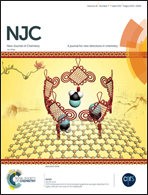A computational study of aromaticity and photophysical properties of unsymmetrical azatrioxa[8]circulenes†
Abstract
Owing to their potential use in organic light-emitting diodes and field-effect transistors we present a theoretical study of a series of unsymmetrical azatrioxa[8]circulenes in order to explain the impact of outer substituents and benzoannelation on photophysical constants and aromaticity of these compounds in terms of spin–orbit coupling perturbation and magnetically-induced ring currents. It is argued that the S1–Tn inter-system crossing processes constitute the main deactivation pathways for the fluorescence quenching, something that is supported by a good agreement obtained with experimental data on fluorescence quantum yields. The concept of the gauge-including magnetically induced currents has been applied in order to estimate the role of substituents and benzoannelated fragments on the aromaticity and particularly on the overall balance between the diatropic “aromatic” and paratropic “antiaromatic” current strengths. While a variation of the substituents in the outer perimeter of the studied circulenes does not provide a clear effect on their aromaticity, it is demonstrated that an additional benzoannelation (π-extension) of the azatrioxa[8]circulene macrocycle induces a significant aromaticity enhancement.
![Graphical abstract: A computational study of aromaticity and photophysical properties of unsymmetrical azatrioxa[8]circulenes](/en/Image/Get?imageInfo.ImageType=GA&imageInfo.ImageIdentifier.ManuscriptID=C6NJ03925A&imageInfo.ImageIdentifier.Year=2017)


 Please wait while we load your content...
Please wait while we load your content...